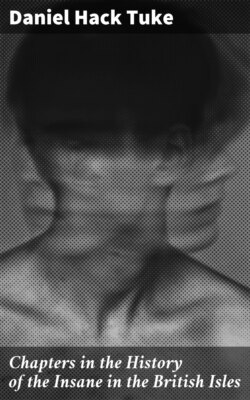Читать книгу Chapters in the History of the Insane in the British Isles - Daniel Hack Tuke - Страница 12
На сайте Литреса книга снята с продажи.
Footnotes
ОглавлениеTable of Contents
[Skip]
[57] Dugdale's "Monasticon," vol. vi. pt. ii. pp. 621, 622. Rot. Claus. de ann. 4 Hen. IV. Videsis bundell. de beneficii Alienig. de anno 48 Edw. III. Et. Pat. 11 Edw. II. p. 2, m. 24. The Hospital or Priory of Bethlem must not be confounded with the Priory of St. Mary Spital, or New Hospital of our Lady without Bishopsgate, founded 1197.
The following were Masters or Priors of the Hospital: Robert Lincoln, 12 Rich. II.; Robert Dale, 1 Hen. IV.; Edw. Atherton, 15 Hen. VI. He was clerk of the closet to the King. John Arundel, 35 Hen. VI.; Thomas Hervy, 37 Hen. VI.; John Browne, later in the same year; John Smeathe or Sneethe, 49 Hen. VI. John Davyson was removed 19 Edw. IV., when Walter Bate and William Hobbes were made custodes, with benefit of survivorship as Master to either (Dugdale, op. cit., p. 622).
[58] French, crèche, a manger.
[59] Argent, two bars sable, a labell of five points, throughout gules, on a chief azure, an estoile of sixteen points, or, charged with a plate thereon, a cross of the third between a human skull, in a cup on the dexter side, and a basket of bread, i.e. wastell cakes, all of the fifth, on the sinister.
[60] Stow, edit. 1603, p. 452. On Bethlem, see p. 166.
[61] "More pity that the eagle should be mewid, while kites and buzzards prey at liberty" (Shakespeare). As hawks were caged while moulting or mewing (Fr. mue, from mutare), a mew or mews came to mean a place of confinement. "Stable so called from the royal stables in London, which were so named because built where the king's hawks were mewed or confined" (Webster). Wordsworth has "violets in their secret mews." An asylum might be correctly styled a "Lunatic Mews."
[62] Op. cit., p. 139.
[63] Act i. sc. 4.
[64] "The Workes of Sir Thomas More," vol. ii. p. 901. Edit. London, 1557.
[65] Malcolm's "Londinum Redivivum," 1803, vol. i. p. 351.
[66] Charity Commissioners' Report, 1837, from which much valuable information has been derived.
[67] See note on Bethlem, Appendix A.
[68] "A contest had long subsisted between the Common Council of the City of London and the acting governors of all the royal hospitals, the former claiming a right to be admitted governors in virtue of the several royal charters. This dispute has been happily settled by a compromise which allows the admission of twelve of the Common Council to each hospital," by the Act of 1782 (Bowen's "Historical Account of Bethlem," 1783).
[69] Charity Commissioners' Report, 1837, p. 390.
[70] See Munk's "Roll of the Royal College of Physicians," vol. i. p. 177.
[71] Edit. 1877, vol. v. p. 472.
[72] Appointed apothecary to Bethlem, 1795.
[73] "Natural History of Wiltshire," p. 93.
[74] London Gazette, No. 1000.
[75] This charter appears to grant more than the mere patronage of the hospital.
[76] Evelyn's Diary, vol. ii. p. 119 (edit. 1850).
[77] The houses in Charing Cross and Barking, while earlier than Bethlem as receiving the insane exclusively, were, of course, on a very small scale compared with the Moorfield Asylum.
[78] Noorthouck's "A New History of London," 1773.
[79] In fact, it was built on the plan of the Tuileries, which is said to have greatly incensed Louis XIV.
[80] Not of brass, but of Portland stone. One of the figures was said to represent Oliver Cromwell's porter, who was a patient in the first Bedlam. In 1814 they were "restored" by Bacon (the younger).
[81] Pennant's "London," edit. 1793, p. 267.
[82] Smith, op. cit., p. 35.
[83] Cf. Ireland's "Hogarth," vol. i. p. 64, for description of this plate.
[84] Page 61. Written in 1703.
[85] Malcolm, in his "Londinum Redivivum," 1803 (vol. i. p. 351), says, "The back part of the hospital, next London Wall, is too near the street. I have been much shocked at the screams and extravagances of the sufferers when passing there. This circumstance is to be deplored, but cannot now be remedied."
[86] Proceedings of the Committee and Reports from Surveyors respecting the state of Bethlem Hospital in 1800 and 1804. London, 1805.
[87] Charity Commissioners' Report, 1837.
[88] Bethlem expended £606 in 1814 and 1816, in opposing the "Mad-house Regulation Bill."
[89] See Dr. Munk's "Roll of the College of Physicians," vol. i. p. 361. For notices of the Monros, see the same work. An interesting series of portraits of this family are in the possession of the College.
[90] "Roll of the College of Physicians," by Dr. Munk, vol. i. p. 428.
[91] Dr. Munk.
[92] Edinburgh Review, 1817, p. 443.
[93] Exemption from the operation of previous Acts had been obtained by 22 Geo. III., c. 77, s. 58; 9 Geo. IV., c. 40; and 2 and 3 Will. IV., c. 107, s. 62.
[94] A view of the hospital may be seen in the Print Room of the British Museum: vide manuscript "Index to Views," vol. viii. print 253. It is anything but inviting. Print 257 exhibits the building in Old Street.
[95] "The Battiad," attributed to Moses Mendez, Paul Whitehead, and Dr. Schomberg.
[96] See Thornbury's "Old and New London," vol. ii. p. 200.
[97] "Some Account of London," 3rd edit. 1793, p. 268.
[98] Manuscript memorandum of a visit to St. Luke's in 1812, by S. Tuke.
[99] These particulars are taken from St. Luke's Annual Report of 1851, containing a retrospective sketch of its history, for the use of which we are indebted to the present superintendent, Dr. Mickley. Statistics of recovery are given for different periods, but the fallacies attending such comparisons are so great that I have not cited the figures.
